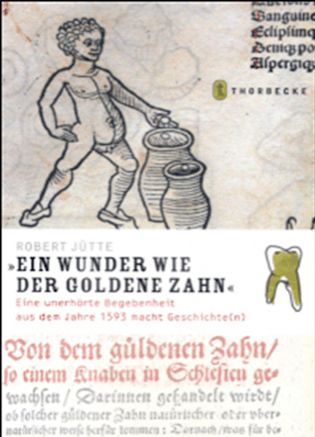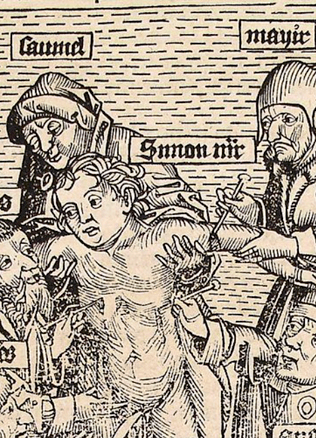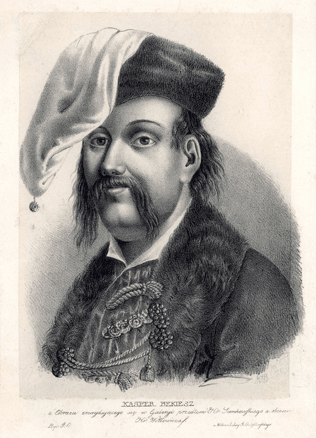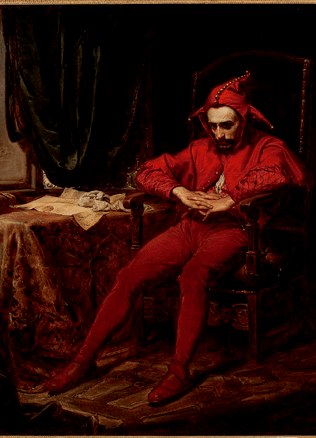Gediminas, the Stable Hand
A scandal broke at the Council of Constance in the fall of 1416. A German Dominican, John of Falkenberg, who had served for the Teutonic Order (however who belonged to a Polish monastery and had earlier worked at Krakow University) disseminated his Satira where he mocked Jagiełło and Vytautas, who were ruling Poland and Lithuania respectively at the time. He struck a sensitive spot, that being their royal origins. John of Falkenberg declared in a straightforward manner that the reigning rulers were of poor stock – he said their “ancestor was a shoe maker.” Falkenberg asserted that Jagiełło was a despicable pagan Lithuanian, a persecutor of Christians, who was not worthy to even rule the good-for-nothing country that was Poland. He threatened the Europeans with the plans of Vytautas and Jagiełło to conquer the entire territory to the Rhine and spread rumours of suspected promises of Vytautas to “water his horses in the Rhine.” The tract was spiteful, and led to great discontent among the Poles and Lithuanians. While the council was still in session, Falkenberg was thrown into jail. His work was declared unsuitable and “worthy of being trampled,” however the assembly of bishops did not discern any heresy in his work. This angered the Poles, who even stormed the pope’s residence.
A short historical memory
The Satira only mentions in passing the common origins of Vytautas and Jagiełło, which after some time was expanded upon in a separate work by the Teutonic Order in the Summarium entitled A Short Story About Jagiełło and Vytautas, in which the following was written: “Once there lived a powerful king of Lithuania and Samogitia, with the name Vytenis (…) When he died, Gediminas, his stable boy (pferdemarschalk), became king. This Gediminas is the grandfather of Jagiełło, the current King of Poland. Thus we can see that the king of Poland is not of royal ancient stock, but is of poor gentry stock.” There was a battle raging over Samogitia, and the Teutonic Order threw doubt upon the dynasty of the rulers of Poland and Lithuania. In the Middle Ages, venerable personal or family origins were one of the primary categories that showed one’s right to rule.
Ruling dynasties and noble families created genealogical stories that tried to take their family line deep into the past and find an exceptional “founder” of the family.
In wanting to discredit someone, there was reason to discuss his roots. It’s difficult to say where Falkenberg and other writers from the Teutonic Order took their information from concerning Jagiełło and Vytautas’ past. They used the archive of the Teutonic Order, and perhaps read old chronicles. The choice of Gediminas’ origins was poignant – it is doubtful that even those around the Lithuanian rulers knew about their ancestors before Gediminas. In the chronicle Lithuanian Grand Dukes Chronicle created on the order of Vytautas, the rulers’ history started with his grandfather Gediminas, but earlier rulers are not mentioned. And the only thing we know about Gediminas is his last decision, which is dividing up of the country to his seven sons. Neither in Poland nor in Lithuania did genealogical information appear at the time where the origins of the Gediminid dynasty were revealed and explained in greater detail. The first time Lithuanian sources mentioned Vytenis, the historical predecessor of Gediminas, was only at the beginning of the 16th century (in a new redaction of the Lithuanian Chronicles). The name of Vytenis was most likely taken by ancient Lithuanian historians from German or Polish sources and mistakenly considered him Gediminas’ father, and not brother. It was only 19th century historians that found earlier ancestors of the Gediminid dynasty (Putavyras, Butvydas and Butigeidis).
Careless accusations by Moscow backfired
It was only the weakness of the Teutonic Order that did not allow them to use this version of Gediminas’ origins for their further political aims. In 1422 there was the “eternal” peace treaty of Melno made between the Grand Duchy of Lithuania and the Teutonic Order, which led to the beginning of the period of peaceful relations among them. However after more than 100 years the stable boy version was revived during another political conflict. In 1492 with the start of a long-term war between Lithuanian and Moscow, both sides attempted to base the right to the territories that were fighting over with theoretical and historical arguments.
It was in this atmosphere that Russian chroniclers employed the use of the theory that came from Teutonic Order about the low birth of Gediminas.
Russian chronicles tell of how Vytenis’ stable boy Gediminas killed his master and usurped his state. Thus, the low birth of the Jagiellon dynasty ruling Poland and Lithuania was put up against those of the Rurik dynasty ruling Rus’, who at that time began deriving their origins from Roman Emperor Augustus. After some time the story of “Gediminas the stable boy” was not to be found anymore in the Russian chronicle tradition. Most likely it was understood in Moscow that this theory not only put the dynasties of Poland and Lithuania in an uncomfortable situation, but also the Gediminid dukes Bielskis, Mstislavskis that were refugees living in Moscow at the time and even Muscovite rulers, the patriarchal blood lines of which (through Vytautas’ daughter Sofija) came from Gediminas’ family. This is why Gediminas’ origins were “modified” by proclaiming him as a descendent of Polotsk dukes from the Rurik dynasty. It was this tradition that was fixed in the official genealogical trees of Russian rulers. In 1567 the Grand Prince of Moscow Ivan IV wrote in a letter to the ruler of Poland and Lithuania Sigismund Augustus that occasionally one found those who falsely stated that Vytenis had supposedly been a “slave.” And a few years later after Sigismund Augustus’ death, he laid claim to the throne of the Commonwealth of Two Nations as a distant relative of Lithuanian rulers.
Do You Know?
Though venerable origins were of particular importance in the Middle Ages, with the lack of a tradition of writing, earlier ancestors were quickly forgotten. Even in the court of Lithuanian rulers is it doubtful that anything was known about their ancestors before Gediminas. This allowed the Teutonic Order to spread a discrediting story about the lowly origins of the Gediminid dynasty from a stable master.
It was in this way the theory of the low birth of the Gediminid dynasty was laid to rest. There were familial ties of various kinds that inevitably bound the rulers of different countries together who were fighting among one another, which forced them to construct more detailed stories about the past of their own rulers as well as those of other countries. The origins of Gediminas and his family remain hovering in the fog of sources from the end of the 13th century.
Rimvydas Petrauskas



